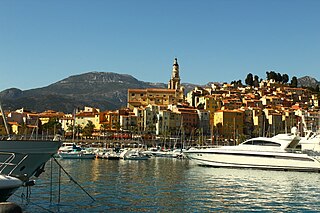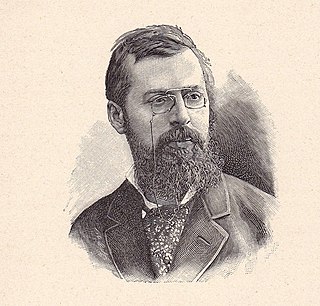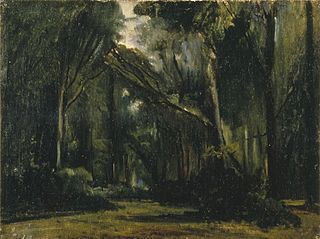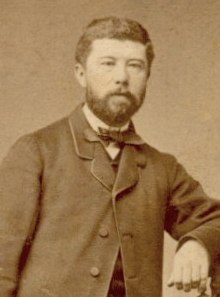
DoñaMaría Eugenia Ignacia Agustina de Palafox y Kirkpatrick, 19th Countess of Teba, 16th Marquise of Ardales, known as Eugénie de Montijo, was Empress of the French from her marriage to Napoleon III on 30 January 1853 until the Emperor was overthrown on 4 September 1870. From 28 July to 4 September 1870, she was the de facto head of state of France.

John Singer Sargent was an American expatriate artist, considered the "leading portrait painter of his generation" for his evocations of Edwardian-era luxury. He created roughly 900 oil paintings and more than 2,000 watercolors, as well as countless sketches and charcoal drawings. His oeuvre documents worldwide travel, from Venice to the Tyrol, Corfu, Spain, the Middle East, Montana, Maine, and Florida.

Charles IV was King of Spain and ruler of the Spanish Empire from 1788 to 1808.

Compiègne is a commune in the Oise department in northern France. It is located on the river Oise. Its inhabitants are called Compiégnois.

Menton is a commune in the Alpes-Maritimes department in the Provence-Alpes-Côte d'Azur region on the French Riviera, close to the Italian border.

Anne-Louis Girodet de Roussy-Trioson, also known as Anne-Louis Girodet-Trioson or simply Girodet, was a French painter and pupil of Jacques-Louis David, who participated in the early Romantic movement by including elements of eroticism in his paintings. Girodet is remembered for his precise and clear style and for his paintings of members of the Napoleonic family.

The Armistice of 22 June 1940, sometimes referred to as the Second Armistice at Compiègne, was an agreement signed at 18:36 on 22 June 1940 near Compiègne, France by officials of Nazi Germany and the Third French Republic. It became effective at midnight on 25 June.

Albert Robida was a French illustrator, etcher, lithographer, caricaturist, and novelist. He edited and published La Caricature magazine for 12 years. Through the 1880s, he wrote an acclaimed trilogy of futuristic novels. In the 1900s he created 520 illustrations for Pierre Giffard's weekly serial La Guerre Infernale.

Alfred Jules Émile Fouillée was a French philosopher.

The Forest of Compiègne is a large forest in the region of Picardy, France, near the city of Compiègne and approximately 80 kilometres (50 mi) north of Paris.

Maria Luisa of Parma was, by marriage to King Charles IV of Spain, Queen of Spain from 1788 to 1808 leading up to the Peninsular War. Her relationship with Manuel Godoy and influence over the King made her unpopular among the people and aristocrats. She was rivals with the Duchess of Alba and the Duchess of Osuna. The death of her daughter-in-law Princess Maria Antonia of Naples and Sicily, whom she disliked, was said to be the poisoning by the Queen.

Luis Barragán House and Studio, also known as Casa Luis Barragán, is the former residence of architect Luis Barragán in Miguel Hidalgo district, Mexico City. It is owned by the Fundación de Arquitectura Tapatía and the Government of the State of Jalisco. It is now a museum exhibiting Barragán's work and is also used by visiting architects. It retains the original furniture and Barragán's personal objects. These include a mostly Mexican art collection spanning the 16th to 20th century, with works by Picasso, Diego Rivera, José Clemente Orozco, Jesús Reyes Ferreira and Miguel Covarrubias.
Tim White-Sobieski is a video and installation artist based in New York and Berlin. He was educated as an architect and dedicated himself to visual art and filmmaking, exploring the fields of painting, sculpture, photography, video, video installations and light installations throughout his career. He began showing in New York in the early 1990s with his "Blue Paintings." Emphasis on the role of the subconscious in his paintings had affinities with visual abstractionism and literary existentialism.

Luis Ramiro Barragán Morfín was a Mexican architect and engineer. His work has influenced contemporary architects visually and conceptually. Barragán's buildings are frequently visited by international students and professors of architecture. He studied as an engineer in his home town, while undertaking the entirety of additional coursework to obtain the title of architect.
Joseph-Auguste Lafollye (1828-1891) was a French architect. He is known for his restoration of the Château de Pau and other major public buildings.

Gabriel-Auguste Ancelet was a French architect who undertook various projects for the Emperor Napoleon III, and later taught for many years at the École des Beaux-Arts in Paris.
Louis-Martin Berthault was a French architect, decorator, engraver and landscape artist.

Les Colombières is a villa in Menton, in the Alpes-Maritimes department on the French Riviera. The gardens of the villa were designed by Ferdinand Bac between 1918 and 1927. Bac also designed modernist furniture for the house and personally painted all the villa's frescos and paintings. The gardens are 7.4 acres (3.0 ha) in size, and have been described as full of "wit, brilliance and imagination" that "inspire both the intellect and the imagination".

La Caricature was a satirical journal that was published in Paris, France, between 1880 and 1904. It had a lively and colorful layout, and made full use of the newly invented photogravure technology. Its focus was on social satire rather than political commentary. La Caricature covered the theater, news events, gossip and topical subjects such as the vote for women or seaside vacations. The founding editor, Albert Robida, left in 1892. The journal began to decline in quality, went through various changes of ownership and management, and eventually was merged with a rival tabloid.

The equestrian statue of Ferdinand Foch stands in Lower Grosvenor Gardens, London. The sculptor was Georges Malissard and the statue is a replica of another raised in Cassel, France. Foch, appointed Supreme Commander of the Allied Forces on the Western Front in the Spring of 1918, was widely seen as the architect of Germany's ultimate defeat and surrender in November 1918. Among many other honours, he was made an honorary Field marshal in the British Army, the only French military commander to receive such a distinction. Following Foch's death in March 1929, a campaign was launched to erect a statue in London in his memory. The Foch Memorial Committee chose Malissard as the sculptor, who produced a replica of his 1928 statue of Foch at Cassel. The statue was unveiled by the Prince of Wales on 5 June 1930. Designated a Grade II listed structure in 1958, the statue's status was raised to Grade II* in 2016.



















